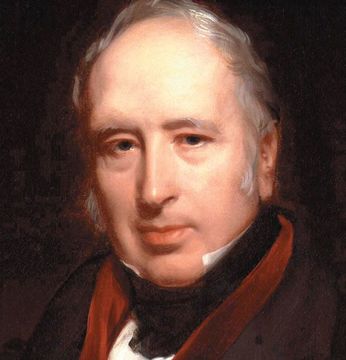
Sir George Cayley, the Father of Aviation
In 1903 Orville and Wilbur Wright launched the world’s first piloted heavier-than-air flying machine, or so history would have us believe. But they were actually 50 years behind eccentric Englishman Sir George Cayley.
Cayley did not pilot his prototype gliders himself; he left that duty in one case to a 10-year-old boy and in another to his coachman. But he was the first person to identify the four-vector forces that influence an aircraft: thrust, lift, drag, and weight. The fact that he regarded his invention as just one of his many amusing hobbies and failed to develop it further probably accounts for his neglect by the general public.
The sixth baronet of Brompton, Cayley was born in 1773 and grew up on an estate called Paradise in northeastern Yorkshire. He served in Parliament and conducted various scientific experiments ranging from measuring the growth of his thumbnail to wetlands drainage systems.
As a young man, he began his study of flight by observing birds and created a prototype helicopter. But unlike many inventors before him, Cayley quickly rejected the notion that an airship required flapping wings. He saw that seagulls changed the angle and shape of their wings to stay aloft, and realized that a man-made glider could do the same. Forward thrust could be achieved not by flapping wings but with a lightweight engine. In 1799 Cayley engraved a design for a manned glider on one side of a small silver disc. On the other side, he diagrammed the forces applied to flight. He continued to refine his invention off and on over the years.
In the early 1840s, one William Henson patented a flying machine and tried to persuade Cayley to invest in his Aerial Transit Company. Cayley had already experimented with engines powered by hot air, gunpowder, and steam. One look at Henson’s machine with its canvas wings and steam locomotive engine and Cayley knew that it wouldn’t work. But it inspired him to turn his attention back to aviation.
In 1849 he built a “governable parachute.” It had a cruciform tail and kite-shaped wing mounted above a cockpit strongly resembling a boat complete with oars, with which the pilot was to row himself through the sky. The 10-year-old son of one of Cayley’s servants flew it for several yards.
Read more
In 1853 (the exact date is not recorded) Cayley’s remodeled parachute was ready for another test run. While a group of local lads ran frantically down a hillside towing the craft, Cayley persuaded his coachman, John Appleby, to jump aboard. He flew 900 feet across Brompton Dale, becoming the first adult to fly in a heavier-than-air machine. Legend has it that Appleby’s first words upon landing were: “Please, Sir, I wish to give notice. I was hired to drive, not fly!” His panic is understandable; Appleby was 79; his employer was 80.
Cayley’s inventions neither began nor ended with aviation. He designed an artificial hand for one of his tenant’s sons and patented a self-righting lifeboat, a caterpillar tractor and a forerunner to the modern tank. An ardent champion of railway safety, he invented brakes, the cowcatcher and signal systems for railways. He is also responsible for the tensioned spoked wheel that made possible both the bicycle and the London Eye ferris wheel.
In 1832 Cayley established the British Association for the Advancement of Science. In 1838 he founded the Royal Polytechnic Institution, now the University of Westminster, and served as its chair for many years. The Aeronautical Society for which he campaigned was formed nine years after his death in 1857.
Cayley’s achievements went largely unnoticed over the years, even though in 1974 a replica of his craft flew in approximately the original spot. It wasn’t until the hoopla surrounding the anniversary of the Wright brothers’ flight that champions came forward to press Cayley’s claim.
In 2003 Sir Richard Branson flew the replica, by then called the Cayley Glider, over Brompton Dale, with a large crowd in attendance. Now a memorial is in the works for the man who has been belatedly called the “Father of Aviation.”
The replica of the Cayley Glider can be seen at the Yorkshire Air Museum, along with a Wright Flyer replica. There are blue plaques on Cayley’s houses in London’s Hertford Street, Brompton-by-Sawdon, and Scarborough.
Read more
* Originally published in September 2007.





Comments